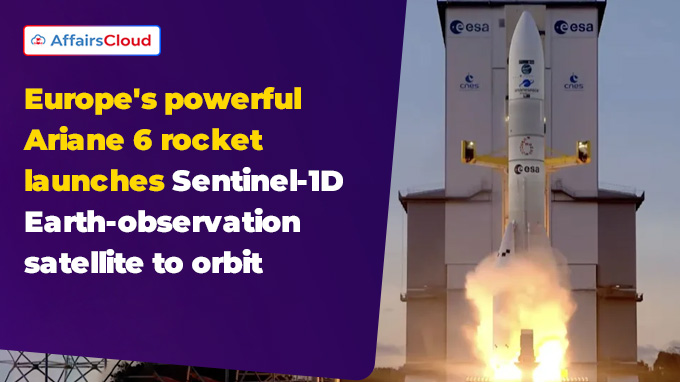In November 2025, the European Space Agency (ESA) and Arianespace launched the Copernicus Sentinel-1D Earth-Observation Satellite (EOS) to Low Earth Orbit (LEO) aboard the Ariane 6 rocket from the Guiana Space Centre in Kourou, French Guiana.
- The Sentinel-1D EOS is part of the Copernicus Sentinel-1 constellation, which plays a vital role in global radar imaging.
Exam Hints:
- What? Launch of Copernicus Sentinel-1D EOS
- Launched by: ESA & Arianespace
- From: From Guiana Space Centre (French Guiana)
- Rocket: Ariane 6
- Engine: Vulcain 2.1 engine, Vinci engine
- Constellation: Copernicus Sentinel-1
- Mission : VA265
- Milestones: 356th Arianespace launch, 4th Ariane 6 mission, 7th Sentinel satellite by Arianespace, 109th Thales Alenia Space spacecraft launch
- Key Objectives: Environmental monitoring, Disaster management, Maritime safety, Urban planning.
About Launches:
Launch Vehicle: The Ariane 6 rocket launched in its A62 configuration, equipped with two solid rocket boosters, a cryogenic core stage powered by the Vulcain 2.1 engine, and an upper stage using the Vinci engine.
Mission: Designated VA265, this mission represents a major milestone in Europe’s space efforts, improving autonomous access to space and bolstering Earth observation capabilities.
Milestone : Sentinel-1D marks the 356th launch by Arianespace and the 4th mission using Ariane 6. It is also the 7th Sentinel satellite launched by Arianespace and the 109th spacecraft built by Thales Alenia Space to be launched by the company.
Key Objectives: The mission aims to support environmental monitoring (ice, vegetation, deforestation), disaster management (rapid mapping for floods and earthquakes), maritime safety (oil spill detection and ship monitoring), and urban planning (land deformation and infrastructure stability).
About Sentinel-1D:
Overview: The Sentinel-1D satellite marks the fourth and final launch of the first-generation Copernicus Sentinel-1 constellation, finalizing Europe’s high-resolution radar imaging system for Earth observation.
Advanced Imaging: Developed by Thales Alenia Space, Sentinel-1D is equipped with a C-band(4 and 8 gigahertz,GHz) Synthetic Aperture Radar (SAR) that captures high-resolution images of Earth’s surface, day or night, in any weather conditions.
Features: The satellite weighs about 2,300 Kilogram (Kg) and operates in a sun-synchronous orbit at an altitude of about 693 Kms. SAR provides high-resolution imaging between 5 and 25 meters (m) and carries an Automatic Identification System (AIS) to track maritime vessels in real time.
- It provides global coverage with a revisit time under six days and is designed to operate for at least seven years.
Replacement: Sentinel-1D replaces the aging Sentinel-1A and joins Sentinel-1C, forming a two-satellite constellation to maintain uninterrupted Earth observation and radar imaging.
About Ariane 6 Rocket:
Developer: Ariane 6 launch vehicle, developed by ArianeGroup under ESA and Centre National d’Etudes Spatiales (CNES), French National Centre for Space Studies.
Successor: Built to succeed the retired Ariane 5, Ariane 6 delivers greater flexibility and cost-efficiency for diverse space missions.
About European Space Agency (ESA):
Director General (DG) – Josef Aschbacher
Headquarters – Paris, France
Established – 1975




